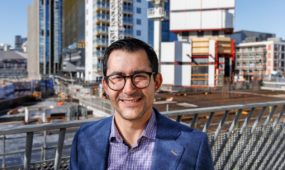Research precinct signals healthy future for industry
Health & Medical

Sign up to receive notifications about new stories in this category.
Thank you for subscribing to story notifications.
WORK is well underway on two more buildings at Adelaide BioMed City as the $3 billion world-class health precinct in South Australia begins to take shape.
The compact precinct sits on the northwest corner of Adelaide, a city contained in a terraced grid, allowing all the buildings to sit side-by-side within easy walking distance of each other and serviced by a tram line.
Construction has begun on the $231 million University of Adelaide Health and Medical Sciences building. It will support Medicine, Nursing and Dentistry students and about 400 health sciences researchers and is due for completion in early 2017. The 12-storey Lyons Architects designed building is the largest capital works project in the university's 140-year history.
Work is also underway on the University of South Australia’s $230m Health Innovation Building.
Designed by BVN Architects and Swanbury Penglase, the 15-storey health and research facility will support a collaborative and holistic approach to health research and is scheduled to open in 2018.
The $2.3 billion new Royal Adelaide Hospital is nearing completion, with the first patients expected to be treated there before the end of the year.
The hospital will sit beside the $200 million SA Health and Medical Research Institute (SAHMRI) building, which opened in late 2013, and is the only part of the site currently operating.
Known by locals as “The Cheese Grater” for its stunning contemporary design, the Woods Bagot-designed building is home to more than 500 researchers and has won a swag of architectural awards.
A $280 million ‘SAHMRI 2’ has been proposed to be constructed alongside the SAHMRI building to house Australia’s first proton therapy unit – an $80 million machine to target otherwise inoperable cancerous tumours. Flinders University has committed $60 million to have a cancer research hub in the building while the State Government has budgeted $44 million. The Federal Government needs to contribute $176 million so the project can go ahead.
There is also talk of building a new Women’s and Children’s Hospital in the hub.
“As the largest greenfield healthcare precinct in the Southern hemisphere, Adelaide BioMed City and the development of the city’s northwest corner is bringing unprecedented investment opportunities to the state,” said Senior Investment Advisor Patrick Robinson from Invest Adelaide.
Health Industries South Australia was created in 2014 as a dedicated organization to leverage the infrastructure and promote the precinct to potential global investors.
Marco Baccanti was lured to Adelaide as its Chief Executive.
The Italian-born Baccanti is a former President of the International Association of Science Parks and has worked extensively in biotechnology, biomedical and healthcare industry development in the Middle East and Europe.
He said Adelaide BioMed City was the result of a clear vision from the State Government to strengthen sustainable knowledge-intensive industries in the state as more traditional industries such as manufacturing waned.
Baccanti said once the buildings under construction were completed, Adelaide Biomed City would have reached a critical mass, making the precinct even more attractive to new investors.
“Investment now means resources channeled into the state to fund some important clinical research activity for instance or some collaboration agreement between a specific therapeutic area being developed at SAHMRI and a biotech company abroad,” he said.
“We are starting to promote the concept and approach the companies, and some of these have evolved to the stage of expression of interest.”
Across North Terrace from the hub, which also has the Adelaide Convention Centre and Central Railway Station as neighbours, plans have been approved for two major developments to complement the health precinct.
Two 23-storey towers, designed by GHD Woodhead, comprising a total of 400 residential apartments and consulting rooms have been given development approval above and behind the state heritage-listed Newmarket Hotel.
The towers will sit next to a 15-storey, 244-room hotel to help service visitors to the medical precinct. The INTRO designed 4.5-star Lester Hotel project, which will include conference rooms, offices, a gymnasium and a ground floor cafe, has also been granted development approval.
SAHMRI Executive Director Professor Steve Wesselingh said clustering had proven very successful in many parts of the world, particularly in the area of health research.
“If you look at the very best places in the world, they talk about the tripartite mission of doing outstanding health research, outstanding clinical care delivery and outstanding teaching all in the same place,” he said.
“We’ll have 10-15,000 people involved in research, teaching and clinical care in this precinct plus the patients and the groups that are lining themselves up along the other side of North Terrace because they see the precinct as being the epicentre of health and medical research.
“It’s incredibly exciting, it takes on the models that have worked the best around the world and it’s directly adjacent to our central business district.
“This will keep the best clinicians and the best scientists in South Australia and it has already attracted people from overseas … and so far they’re staying.
“Adelaide needs to aspire to the level of excellence that we want to have on this precinct in order to compete and do really good things.”
Jump to next article



